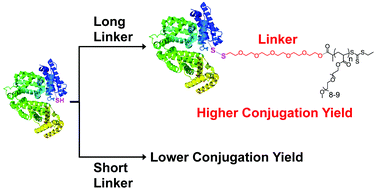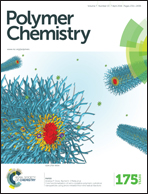Enhancing the conjugation yield of brush polymer–protein conjugates by increasing the linker length at the polymer end-group†
Abstract
Polymers with oligoethylene glycol side chains are promising in therapeutic protein–polymer conjugates as replacements for linear polyethylene glycol (PEG). Branched PEG polymers can confer additional stability and advantageous properties compared to linear PEGs. However, branched PEG polymers suffer from low conjugation yields to proteins, likely due to steric interactions between the bulky side chains of the polymer and the protein. In an effort to increase the yield, the linker length between the protein-reactive functional end-group of the polymer chain and the branched PEG side chain was systematically increased. This was accomplished by synthesizing four well-defined poly(poly(ethylene glycol methyl ether) acrylates) (pPEGAs) with pyridyl disulfide end-groups by reversible addition-fragmentation chain transfer (RAFT) polymerization mediated by chain transfer agents (CTAs) with different linker lengths. These, along with linear PEG and poly(N-isopropylacrylamide) (pNIPAAm), were conjugated to two model proteins, bovine serum albumin (BSA) and beta-lactoglobulin (βLG). The conjugation yields were determined by gel electrophoresis. The length of the linker affected the conjugation yield for both proteins. For BSA, the conjugation yield step increased from 10% to 24% when the linker was altered from 1 ethylene glycol (EG) unit to 3, with no additional increase for 4 and 6 EG units. In the case of βLG, the yield gradually increased from 9% to 33% when the linker length was increased from 1 to 6. PEG and pNIPAAm reacted with yields as high as 75%, further emphasizing the effect of steric hindrance in lowering conjugation yields.


 Please wait while we load your content...
Please wait while we load your content...